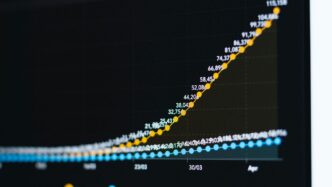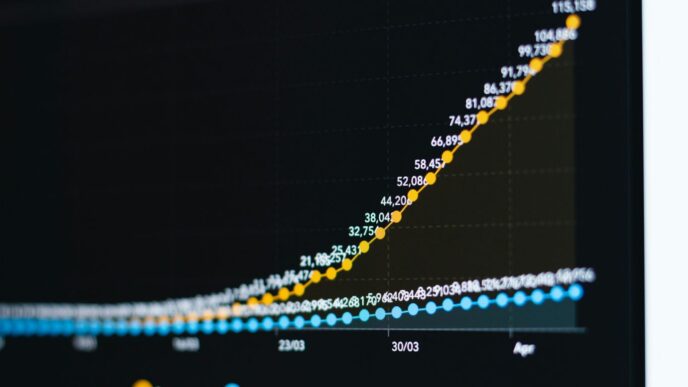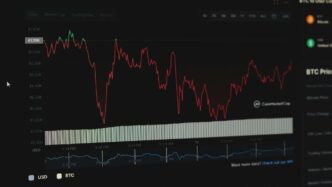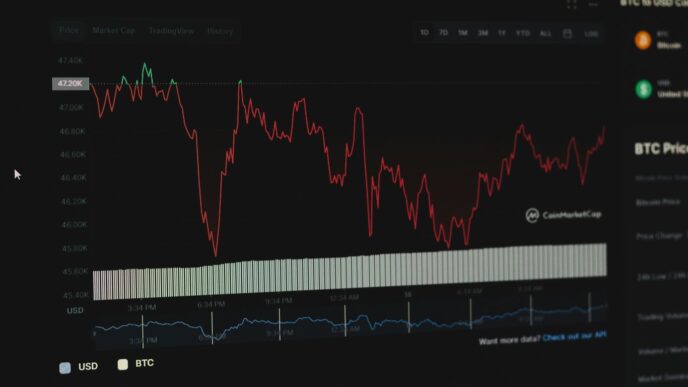Looking for ways to get a little extra cash flow from your investments? You’re not alone. Many people are interested in dividend stocks, and for good reason. These companies pay out a portion of their profits to shareholders, which can add up over time. For 2025, some companies are really standing out with their dividend payouts. We’ve put together a list of some of the top dividend-paying stocks that could be worth a look if you’re aiming to build your wealth with a steady income stream. Remember, though, it’s always smart to do your own homework before putting your money anywhere.
Key Takeaways
- Dividend stocks can offer a steady income stream, which is attractive for many investors, especially those nearing or in retirement.
- Companies with a history of increasing their dividend payouts often show financial stability and a commitment to returning value to shareholders.
- When looking for top dividend-paying stocks, consider factors like dividend yield, payout history, company financials, and industry outlook.
- Investing in dividend stocks can be done directly or through dividend-focused funds like ETFs or mutual funds, offering different levels of diversification.
- It’s important to research individual companies and understand your own financial goals and risk tolerance before investing in any dividend stock.
1. Sysco Corporation
Sysco Corporation is a big name in the food service industry, and for good reason. They’re basically the middleman, supplying everything from fresh produce and frozen foods to kitchen equipment and cleaning supplies to restaurants, hospitals, and schools all over the place. It’s a massive operation, and they hold a significant chunk of the market share.
When it comes to dividends, Sysco has been pretty consistent. They pay out an annual dividend of $2.16 per share, which works out to a yield of about 2.70% as of late 2025. Dividends are handed out quarterly, so you get a little bit of cash back regularly. This steady income stream makes Sysco an interesting option for investors looking for reliable returns.
Here’s a quick look at some key figures:
- Annual Dividend: $2.16 per share
- Dividend Yield: Approximately 2.70%
- Payout Frequency: Quarterly
- Recent Ex-Dividend Date: October 3, 2025
Sysco’s business model is built on scale and efficiency. They manage a huge supply chain, which is no small feat. The company has also been focused on returning capital to shareholders, not just through dividends but also through share repurchases. They’ve planned significant spending on these shareholder returns for the upcoming fiscal year. Looking ahead, Sysco anticipates moderate sales and earnings growth, which should help keep those dividend payments steady. For anyone interested in the food distribution sector, keeping an eye on Sysco’s stock performance is a good idea.
2. M&T Bank Corporation
M&T Bank Corporation, often just called M&T Bank, is a pretty solid player in the banking world, especially if you’re looking for steady dividend income. They operate a couple of regional financial outfits, M&T Bank itself and Wilmington Trust. This setup lets them offer a wide range of services, from everyday banking and loans to more specialized stuff like wealth management and corporate trust services. They’ve got a good footprint across the Eastern U.S., which helps them keep a strong position in their markets.
What’s really interesting for dividend investors is their approach to managing their loan portfolio. They tend to be pretty conservative, which means they often weather economic ups and downs better than some of their competitors. This focus on credit quality is a big plus, especially when the job market gets a bit shaky. Plus, they’ve been actively returning cash to shareholders. In the first half of 2025, M&T Bank put more than $1.7 billion back into buying up its own stock, which can be a good sign for investors.
Here’s a quick look at some numbers:
- Annual Dividend: $6.00 per share
- Dividend Yield: Around 3%
- Dividend Growth Years: 8
- Payout Ratio: Approximately 36%
Analysts seem to like their prospects too, expecting decent growth in both sales and earnings per share for 2025. It seems like M&T Bank is aiming for a balanced approach, growing the business while also rewarding its shareholders.
3. Fifth Third Bancorp
Fifth Third Bancorp, often just called FITB, is a regional bank that’s been around for a while, serving folks and businesses across 13 states in the Eastern U.S. with over a thousand branches. They offer a pretty standard mix of consumer and business banking, plus some wealth and asset management services.
What makes FITB interesting for dividend investors? Well, they’ve been steadily increasing their dividend, showing a commitment to returning cash to shareholders. The bank has a history of improving its efficiency ratio, credit quality, and managing deposit costs, which is good news for its financial health. They’ve also seen their net interest margin go up over the past year, meaning they’re making more on the money they lend out compared to what they pay on deposits.
Here’s a quick look at some numbers for FITB:
| Metric | Value |
|---|---|
| Stock Price | $45.77 |
| Dividend Yield | 3.2% |
| Dividend Growth Yrs | 14 |
| Annual Dividend | $1.48 |
| Payout Ratio | 46.1% |
Analysts seem to think FITB is on a good track, expecting decent growth in sales and earnings per share for 2025. This kind of steady performance and dividend growth is what many income-focused investors look for.
4. Snap-on Incorporated
Snap-on Incorporated is a company that makes and sells tools and diagnostic equipment. They serve industries like vehicle repair, aerospace, manufacturing, and even the military. You can buy their stuff directly from them or through franchisees and distributors.
Snap-on has a history of slow and steady growth, which is pretty good for folks looking for dividends. It seems like customers are pretty loyal, which gives the company good visibility. Plus, they focus on being efficient, which helps their profit margins.
Here’s a quick look at their numbers:
| Metric | Value |
|---|---|
| Stock Price | $325.24 |
| Dividend Yield | 2.6% |
| Dividend Growth Yrs | 15 |
| Annual Dividend | $8.56 |
| Payout Ratio | 45.6% |
They’ve been increasing their dividend consistently, which is a nice perk. For example, they bumped up their quarterly dividend by $0.28 in 2024. Looking back, their sales went from $3.73 billion in 2019 to $4.71 billion in 2024. Earnings per share also saw a good jump, from $12.41 to $19.51 over the same period. While analysts are predicting a slight dip in sales and EPS for 2025, they expect things to pick up again in the mid-single digits the following year. This kind of steady performance is what dividend investors often look for.
5. Fidelity National Financial
Fidelity National Financial, often just called FNF, is a big player in the world of real estate and mortgages. They’re mainly known for providing title insurance and handling all the paperwork when you buy or sell a property. Think of them as the folks who make sure the ownership of a house is clear and that all the money stuff at closing goes smoothly. They also have a side business, F&G, which deals with retirement annuities and life insurance. So, they cover a good chunk of the financial services needed when people are thinking about their future and their homes.
FNF has been paying dividends for a really long time, over 135 years, which is pretty impressive. That kind of history suggests they know how to manage their money and keep shareholders happy. They recently bumped up their quarterly dividend a little bit in 2024, showing a commitment to returning value to investors.
Here’s a quick look at some of their numbers:
| Metric | Value |
|---|---|
| Stock Price | $59.87 |
| Dividend Yield | 3.3% |
| Annual Dividend | $2.00 |
| Payout Ratio | 50.9% |
| 5-Year FCF Growth | 41.1% |
What’s good about FNF is that they’re a leader in their main business, holding a significant share of the title insurance market. They also seem to be in good financial shape, with solid ratings from credit agencies. Plus, their free cash flow is strong and growing, which is exactly what you want to see. It means they have enough money coming in to cover their dividend payments and still have funds left over for things like buying back their own stock, which they’ve been doing. Analysts seem to think they’ll see modest growth in sales and earnings for 2025, which is a steady outlook for a company like this.
6. Cadence Bank
Cadence Bank (CADE) is a regional bank with a presence across the Southern U.S., boasting nearly 400 branches from Texas to Florida. They offer both consumer and business banking services. The bank pays an annual dividend of $1.10 per share, which it last increased in early 2025. This consistent payout, combined with a solid financial footing, makes it an interesting option for dividend investors.
Cadence Bank has been growing, too. Their net interest income saw a significant jump from $805 million in 2021 to $1.4 billion in 2024. This growth is fueled by an active acquisition strategy and steady organic expansion in loans and deposits. Analysts are projecting revenue growth between 10% and 12% for 2025, with earnings per share expected to grow around 10.6%.
Here’s a quick look at some key figures for Cadence Bank:
- Stock Price: $37.64
- Dividend Yield: 2.9%
- Annual Dividend: $1.10
- Payout Ratio: 38.1%
- 5-Year FCF Growth: 43.6%
With a strong market position and a history of growth, Cadence Bank appears to be a stable choice for those seeking reliable income. Their focus on acquisitions and organic growth suggests a forward-looking approach to business expansion. You can find more details on their recent performance and outlook on Cadence Bank’s Q3 CY2025 results.
7. LyondellBasell Industries
LyondellBasell Industries (LYB) is a major player in the global chemical industry, producing plastics and chemicals that end up in all sorts of everyday items. Think food packaging, furniture, car parts, and even paints. They’re a pretty big deal, pulling in over $40 billion in revenue back in 2024.
What’s interesting for dividend investors is their payout. As of late September 2025, LyondellBasell had one of the highest dividend yields in the S&P 500, sitting around 11.1%. That translates to an annual dividend of about $5.48 per share. That’s a pretty solid income stream if you’re looking for that.
Here’s a quick look at their dividend figures:
| Metric | Value |
|---|---|
| Dividend Yield | 11.1% |
| Annual Dividend | $5.48 |
This kind of payout can be attractive, especially when you consider the company’s reach across various essential industries. It’s not just about the chemicals; it’s about how those chemicals are woven into the fabric of modern life and commerce.
8. United Parcel Service
United Parcel Service, or UPS, is a name most of us know. They’re the folks behind those familiar brown trucks zipping around, delivering packages all over the place. But UPS is more than just a delivery service; they also handle supply chain management, which is a pretty big deal for businesses.
Think about it, keeping track of where everything is and making sure it gets to the right spot on time is complicated. UPS has gotten really good at this. In 2024 alone, they were moving an average of 22.4 million packages every single day. That’s a lot of boxes!
For investors looking for steady income, UPS has been a reliable choice. They’ve been paying out dividends, and while the exact numbers can shift, they’ve historically offered a decent yield. This consistent dividend payout makes UPS an attractive option for those seeking regular income from their investments.
Here’s a quick look at some key figures:
- Dividend Yield: Around 7.8% (as of late September 2025)
- Annual Dividend: Approximately $6.56 per share (as of late September 2025)
- Daily Package Volume (2024): 22.4 million
- Total Revenue (2024): About $91 billion
So, if you’re building a portfolio with an eye on dividends and the stability of a well-established company, UPS is definitely worth a second look. They’re a giant in their field, and that size often translates to a certain level of dependability for shareholders.
9. Conagra Brands
Conagra Brands is a name you probably recognize from your grocery store aisles. They own a bunch of popular food brands like Healthy Choice, Marie Callender’s, Slim Jim, and Duncan Hines. Basically, if you’re looking for comfort food or quick meal solutions, Conagra likely has something in its pantry.
This company has been around for a while, and they’ve managed to keep their products relevant. In their 2024 fiscal year, they brought in over $12 billion in revenue. That’s a lot of food! For investors, Conagra has been a consistent payer of dividends, which is great for anyone looking for a steady income stream from their investments.
Here’s a quick look at some key figures:
- Dividend Yield: Around 7.7 percent
- Annual Dividend: Approximately $1.40 per share
It’s not the highest yield out there, but it’s solid, especially when you consider the stability of the food industry. People always need to eat, right? That makes Conagra a pretty dependable choice for dividend income, even when other parts of the economy get a bit shaky. They’ve managed to keep paying out and even growing their dividends over time, which is a good sign for shareholders.
10. Pfizer
Pfizer, a big name in the pharmaceutical world, is known for its wide range of products. They’re involved in everything from cancer treatments and vaccines for diseases to specialty care items. It’s a company that’s been around for a while and has a significant global presence.
While Pfizer’s revenue saw a dip in 2024 compared to 2022, largely due to the winding down of its COVID-19 vaccine business, it still remains a notable player. The company’s focus on innovation in areas like immunology and oncology suggests a forward-looking strategy.
Here’s a quick look at some key figures for Pfizer:
- Annual Dividend: $1.72
- Dividend Yield (approximate): 7.2%
It’s worth noting that the pharmaceutical industry can be quite dynamic, with research and development costs, patent expirations, and regulatory changes all playing a role. For investors, Pfizer represents a blend of established products and ongoing research, aiming to provide both health solutions and shareholder returns.
11. Altria
Altria Group, Inc. (MO) is a name many investors recognize, largely because it’s the company behind Marlboro cigarettes. But Altria is more than just tobacco. They also hold a significant stake in Anheuser-Busch InBev, the brewing giant. For years, Altria’s management has made it clear that they aim to return a large portion of the company’s earnings back to shareholders through dividends.
This commitment has made Altria a go-to for income-focused investors. While the tobacco industry faces its own set of challenges and changing consumer habits, Altria has a history of adapting and maintaining its dividend payouts.
Here’s a quick look at some key figures:
- Dividend Yield: Around 6.5%
- Annual Dividend Per Share: Approximately $4.24
It’s worth noting that the dividend yield can fluctuate based on the stock price. Altria’s strategy often involves balancing its core tobacco business with investments in other areas, aiming to provide a steady income stream for its investors. When considering Altria, it’s important to look at the broader picture of the tobacco industry’s future and the company’s diversification efforts.
12. Verizon Communications
Verizon Communications, a big name in the telecom world, is one of those companies that just keeps showing up on dividend lists. You know them for their cell service, but they’re also involved in broadband and business solutions.
They’ve been paying out dividends for a while now, which is always a good sign for folks looking for steady income.
Here’s a quick look at some numbers:
- Revenue (2024): Around $135 billion
- Dividend Yield: Approximately 6.3%
- Annual Dividend: About $2.76 per share
It’s a pretty straightforward business model – people need to stay connected, and Verizon is one of the main providers. While the tech landscape changes fast, the need for reliable communication seems pretty constant. They’re a major player, and that kind of stability often translates into consistent dividend payments. It’s not the most exciting stock out there, but for a dividend-focused portfolio, it’s definitely worth a look.
13. Dow Inc.
Dow Inc. is a big player in the chemical industry, making all sorts of stuff that goes into things we use every day. Think packaging, plastics, coatings, and materials for building and infrastructure. They’re headquartered in Midland, Michigan, and their products touch a lot of different markets.
Now, about those dividends. It’s important to note that in mid-2025, Dow Inc. made a change, cutting its dividend by half. This brought the annual dividend down to $1.40 per share. While this might seem like a step back for income investors, it’s sometimes a move companies make to reallocate resources or adjust to market conditions.
Here’s a quick look at some of the numbers, keeping in mind the dividend adjustment:
| Metric | Value |
|---|---|
| Dividend Yield | ~6.1% |
| Annual Dividend | $1.40 |
This yield is based on the stock price around the time of the dividend cut. It’s always a good idea to check the current yield as stock prices fluctuate. For investors looking at Dow, it’s worth considering the company’s position in the chemical sector and its plans for future growth alongside its dividend policy.
14. Kraft Heinz
Kraft Heinz is a name you probably know well. Think Kraft Mac & Cheese, Heinz Ketchup, Oscar Mayer hot dogs, and Ore-Ida potatoes. They’ve got a huge collection of food and drink brands that most people have in their kitchens.
The company brought in about $26 billion in sales in 2024, and a big name, Berkshire Hathaway, is their largest shareholder. That’s a pretty solid endorsement, right?
Here’s a quick look at their dividend:
| Metric | Value |
|---|---|
| Dividend Yield | 6.1% |
| Annual Dividend | $1.60 |
For folks looking for steady income from well-known consumer staples, Kraft Heinz is definitely worth a second look. Their products are used every day, which can mean a more stable business, even when the economy gets a little bumpy. It’s not the most exciting company, maybe, but sometimes boring is good when you’re focused on dividends.
15. Franklin Resources
Franklin Resources, often known by its brand Franklin Templeton, is a big player in the investment management world. They handle a massive amount of money for clients, over $1.6 trillion as of late 2024. This isn’t just one company doing its own thing; they have a whole family of asset managers under their umbrella, like Legg Mason and Western Asset Management, each with its own focus.
This global reach and diverse management structure helps them offer a wide range of investment products.
Here’s a quick look at some key figures:
- Dividend Yield: Around 5.5 percent
- Annual Dividend: Approximately $1.28 per share
It’s worth noting that Franklin Resources operates through various well-known names. This means when you invest, you’re tapping into a broad network of financial expertise. They’ve been around for a while, building up a reputation for managing assets across different markets and economic cycles. For investors looking for a steady income stream from a well-established financial services company, Franklin Resources is definitely one to consider.
16. Ford Motor Co.

Ford Motor Company, a name that’s practically synonymous with American automotive history, is still a major player when it comes to dividends. You know, the folks behind the F-150 and the Mustang? They’re not just about building cars; they’re also looking to share some of their success with shareholders.
Ford has been working to make its business more efficient and profitable, which is good news for dividend investors. They’ve been selling millions of vehicles worldwide, bringing in billions in revenue. While the auto industry can be a bit of a rollercoaster, Ford’s established presence and brand recognition give it a certain stability.
Here’s a quick look at some numbers:
| Metric | Value |
|---|---|
| Dividend Yield | ~5.0% |
| Annual Dividend | $0.60 |
When you think about investing in a company like Ford, it’s worth considering a few things:
- Brand Strength: Ford has a long history and well-known brands that many people trust.
- Global Reach: They sell cars all over the world, which helps spread out their business.
- Industry Shifts: Like all automakers, Ford is dealing with changes like electric vehicles and new technologies. How they adapt will be important.
It’s a big company with a lot going on, and for those looking for dividend income from a well-known name in manufacturing, Ford is definitely on the list.
17. Huntington Bancshares
Huntington Bancshares, often just called Huntington, is a pretty solid bank that operates across a good chunk of the U.S. They’ve been around for a while and have built up a decent reputation.
When it comes to dividends, Huntington Bancshares is on our list because they pay out a regular dividend to their shareholders. This consistent payout makes it an attractive option for investors looking for a steady income stream. They’ve managed to keep their dividend payments going, which is always a good sign for a company’s financial health.
Here’s a quick look at some of their dividend details:
- Annual Dividend: $0.62 per share
- Dividend Yield: 3.91%
- Distribution Frequency: Quarterly
It’s worth noting that the banking sector can be a bit sensitive to interest rate changes and the overall economic climate. However, Huntington has shown resilience in its operations. They focus on a diversified loan portfolio and managing their expenses well, which helps them maintain profitability even when things get a little bumpy. If you’re interested in learning more about their financial performance, checking out their investor relations page is a good idea. They also have a history of share repurchases, which can add value for shareholders too. For those keeping an eye on their investments, understanding the latest dividend information is key.
18. First Interstate BancSystem

First Interstate BancSystem (FIBK) is a bank holding company that operates across several states in the Western U.S., offering a range of banking and wealth management services. They’ve been around for a while, building a reputation for solid financial practices. For folks looking for dividend income, FIBK has been a consistent payer, and importantly, they’ve managed to grow that dividend over time.
The bank’s dividend yield has been quite attractive, often sitting above the average for its sector. This makes it a point of interest for investors focused on income generation. They tend to keep a close eye on their loan portfolio, aiming for a diversified and stable mix, which is a good sign, especially when the economy gets a bit bumpy.
Here’s a quick look at some key figures:
- Dividend Yield: Around 5.75% (as of recent data)
- Dividend Growth: Positive history of increasing payouts
- Business Focus: Consumer and business banking, wealth management
- Geographic Reach: Primarily Western U.S.
When you’re looking at banks for dividends, it’s not just about the current yield. You want to see a company that can keep paying and growing that dividend. First Interstate BancSystem seems to be doing just that by managing its operations efficiently and keeping its financial house in order. It’s the kind of steady player that can add a reliable income stream to a diversified investment portfolio.
19. Ennis
Ennis, Inc. is a company that makes and sells a lot of different printed products. Think about things like business forms, checks, presentation folders, and even labels. They’ve been around for a while, and they’ve built a solid reputation in the printing industry.
What’s interesting about Ennis for dividend investors is their consistent payout. They’ve managed to keep paying out dividends, which is a good sign for stability. It shows they’re generating enough cash from their operations to share with shareholders.
Here’s a quick look at some of their dividend details:
- Dividend Yield: Around 5.56% (as of late 2025). This is a pretty good number compared to many other companies out there.
- Dividend Payout Ratio: This tells you how much of their earnings they’re paying out as dividends. A lower ratio often means there’s more room for the dividend to grow or be maintained even if earnings dip a bit.
- Dividend History: While not always perfect, looking at their track record can give you a sense of their commitment to returning capital to investors.
When you’re looking at a company like Ennis, it’s not just about the current yield. You want to consider if their business model is still relevant and if they can keep making money in the future. The printing industry has changed a lot with digital technology, but there’s still a demand for physical printed materials, especially for businesses that need specific types of forms and marketing materials. Ennis seems to be finding its place in that market.
20. Employers Holdings
Employers Holdings, often seen under the ticker EIG, is a company that focuses on providing workers’ compensation insurance. They’ve been around for a while, and for folks looking for steady income from their investments, they’ve been a consistent payer of dividends.
The company’s dividend yield has hovered around the 3% mark, which might not sound huge, but when you consider the stability it offers, it becomes more attractive. It’s not a flashy stock, but it’s the kind of company that tends to chug along, paying out its profits to shareholders.
Here’s a quick look at some key figures:
- Market Cap: Around $719 million (as of late 2025).
- Primary Business: Workers’ compensation insurance.
- Dividend Yield: Approximately 3.06% (based on recent data).
- Dividend Payout Ratio: Generally kept at a conservative level, meaning they aren’t paying out too much of their earnings, which helps keep the dividend sustainable.
When you’re looking at dividend stocks, it’s not just about the yield. You want to see if the company can actually afford to keep paying and maybe even increase that dividend over time. Employers Holdings seems to fit that bill for many investors who prioritize reliability over high growth. They operate in a niche market, and their focus on that specific area has helped them maintain a solid position.
21. Douglas Dynamics
Douglas Dynamics is a company that makes attachments for light trucks and utility vehicles. Think snowplows, salt spreaders, and other gear that helps people do their jobs, especially in tough weather. They’ve been around for a while and have built a solid reputation in their niche.
The company’s focus on essential equipment for professionals in industries like landscaping, construction, and municipal services gives it a steady demand. This isn’t a flashy tech company; it’s more about practical tools that get used year after year. That kind of reliability often translates into consistent performance for investors.
Here’s a quick look at some key aspects:
- Product Focus: They specialize in vehicle attachments, which means they aren’t trying to be everything to everyone. This specialization can lead to deeper expertise and stronger market positions.
- Customer Base: Their customers are often businesses that rely on these tools for their livelihood. This can create a sticky customer base, as switching providers might mean learning new equipment or dealing with compatibility issues.
- Dividend History: Douglas Dynamics has a track record of paying and sometimes increasing its dividend. For those looking for income from their investments, this is a big plus. It suggests the company is generating enough cash to return some of it to shareholders.
While specific dividend yield and growth figures can change, the underlying business model of providing necessary equipment suggests a stable foundation. It’s the kind of company that might not make headlines, but it could be a dependable part of a diversified portfolio aiming for steady returns.
22. Dillard’s
Dillard’s is a department store chain that operates across the United States. While it might not be the first name that comes to mind for dividend investors, it has shown a consistent ability to return capital to shareholders. The company’s dividend yield has been notable, making it an interesting option for those looking for income from their investments.
Here’s a quick look at some key figures:
- Dividend Yield: Around 4.52% (as of late 2025)
- Business Model: Operates a chain of mid-range to upscale department stores, focusing on apparel, cosmetics, and home furnishings.
- Financial Health: Dillard’s has historically managed its inventory and operations effectively, which can translate into stable cash flow to support dividend payments.
When considering Dillard’s, it’s worth looking at how its dividend compares to its earnings and cash flow. A healthy payout ratio suggests the dividend is sustainable. For investors, this means a potential for steady income, though like any retail company, it’s subject to consumer spending trends.
23. Columbia Banking System
Columbia Banking System (COLB) is a financial institution that has been showing up on lists of solid dividend payers. It’s not the biggest name out there, but for folks looking for steady income, it’s worth a look. They operate primarily in the Pacific Northwest, which is a pretty stable economic region.
The company’s dividend yield is currently around 5.53%, which is quite attractive. This means for every $100 you invest, you could expect about $5.53 back in dividends over the year, assuming the dividend stays the same. It’s important to remember that dividend yields can change as the stock price fluctuates.
Here’s a quick look at some key points:
- Dividend History: While specific growth years aren’t always highlighted for every bank, companies like COLB often aim for consistent payouts. It’s always a good idea to check their latest investor relations reports for the most up-to-date dividend history.
- Financial Health: Banks are heavily regulated, and Columbia Banking System generally maintains a decent capital position. This is important because it suggests they can continue to pay dividends even if the economy hits a rough patch.
- Regional Focus: Their concentration in the Pacific Northwest means they understand the local market well. This can lead to better lending decisions and a more stable customer base compared to banks spread too thin.
When considering any stock, especially for dividends, it’s wise to look at the bank’s overall financial statements and future outlook. You can find more details about their performance on sites like Columbia Banking System’s investor page.
24. Citizens & Northern
Citizens & Northern, often just called CZNC, is a bank holding company that operates primarily in Northern Pennsylvania. It’s been around for a while, building a reputation for steady service in its community. For folks looking for dividend income, CZNC has been a consistent payer.
The company has a history of increasing its dividend, which is always a good sign for investors. They’ve managed to keep their payouts growing, even when the economy gets a bit bumpy. This reliability is a big draw for those who want their investments to provide a predictable income stream.
Here’s a quick look at some of the numbers:
| Metric | Value |
|---|---|
| Dividend Yield | 5.59% |
| Dividend Rating | ★★★★★☆ |
When you look at banks like Citizens & Northern, you want to see a few things:
- Solid Financial Health: They need to be well-capitalized and manage their loans carefully. This means keeping an eye on things like loan loss provisions and net interest margins.
- Consistent Profitability: A bank that can reliably make money quarter after quarter is more likely to keep paying and growing its dividend.
- Community Focus: CZNC’s strength comes from its deep roots in its operating regions. This local connection often translates to strong customer loyalty and a stable deposit base, which are vital for any bank.
While it might not be the flashiest company out there, Citizens & Northern offers a straightforward approach to dividend investing. It’s the kind of stock that might appeal to investors who value stability and a dependable income source over rapid growth.
25. Banco Latinoamericano de Comercio Exterior S. A and more
When we talk about dividend stocks, we often focus on the big names we see every day. But there are plenty of other companies out there that might not be on your radar but still offer a solid dividend. Banco Latinoamericano de Comercio Exterior S. A., often just called BLX, is one of those. It’s a bit different from the usual banks you might see in the U.S. market, as it focuses on trade finance and development in Latin America.
BLX offers a dividend yield that has been quite attractive, often sitting above 5%. This makes it stand out, especially when you’re looking for income from your investments. It’s not just about the current payout, though. Investors often look at how sustainable that dividend is and if the company has room to grow it over time.
Here’s a quick look at some points to consider:
- Geographic Focus: BLX operates across various Latin American countries, which means its performance can be tied to the economic health of that region. This can bring both opportunities and risks.
- Business Model: The bank specializes in trade finance, which involves financing international trade transactions. This is a niche but important part of global commerce.
- Dividend History: While specific dividend growth years might vary, companies like BLX that consistently pay dividends are often favored by income-focused investors. It’s worth checking their recent payout history and any stated dividend policies.
It’s always a good idea to look beyond the most common names. Companies like BLX can add diversification to your portfolio and provide a different kind of income stream. Just remember to do your homework on any company before investing, understanding its business, its market, and its financial health.
Wrapping It Up
So, we’ve looked at some companies that seem pretty good at paying out dividends. It’s not always about chasing the fastest-growing stocks; sometimes, getting a steady bit of cash regularly is what really helps build your money over time. These companies we talked about have a history of sharing their profits with shareholders, and that’s a good sign for the future. Remember, though, investing is personal. Always do your own homework and pick what makes sense for your own money goals and how much risk you’re okay with. Investing in dividend stocks can be a smart move for a more stable portfolio, especially when things feel a bit shaky out there.
Frequently Asked Questions
What exactly are dividend stocks?
Dividend stocks are shares in companies that share a portion of their profits with their owners, called shareholders. Think of it like a company giving you a small ‘thank you’ payment just for owning a piece of it. These payments, called dividends, are usually given out regularly, like every few months.
Why should I consider dividend stocks for 2025?
Dividend stocks can be a smart choice because they offer two ways to make money: the dividend payments themselves and the chance that the stock’s price will go up over time. They can provide a steady stream of income, which is especially nice when the economy is a bit unpredictable.
Are all dividend stocks the same?
Not at all! Some companies pay out a lot of their profits as dividends, while others pay out less. Some companies have been paying and increasing their dividends for many years, showing they are very stable. It’s important to look at how much they pay, how often they pay it, and if they can keep paying it.
How do I actually buy dividend stocks?
To buy dividend stocks, you’ll typically need to open an investment account with a brokerage. This is like a special bank account for buying and selling stocks. Once your account is set up and you’ve put money into it, you can choose which companies’ stocks you want to buy.
What’s the difference between a dividend yield and a dividend growth?
Dividend yield is like the percentage of the stock’s price you get back each year as a dividend. Dividend growth is about how much the company increases its dividend payment over time. A company that grows its dividend consistently is often seen as a sign of a healthy and strong business.
Can I lose money investing in dividend stocks?
Yes, just like with any investment, you can lose money. The price of the stock can go down, and sometimes companies might have to reduce or stop their dividend payments if they aren’t doing well financially. That’s why it’s super important to do your homework and understand the companies you’re investing in.














